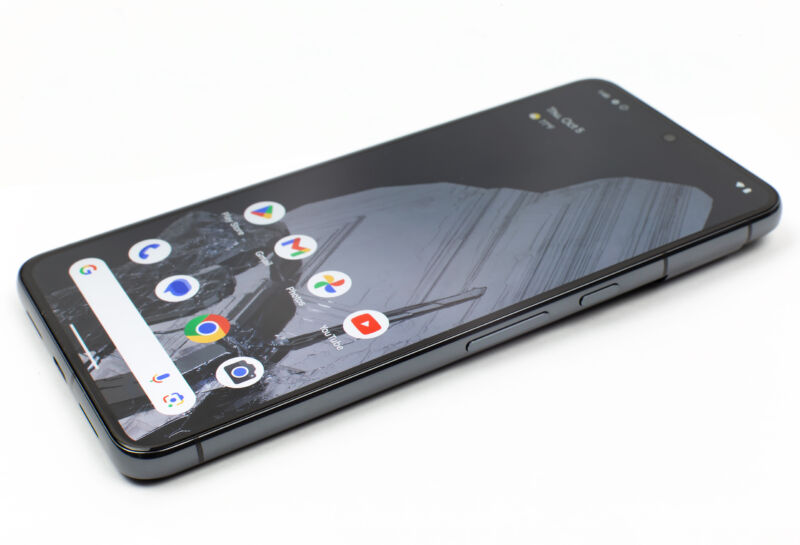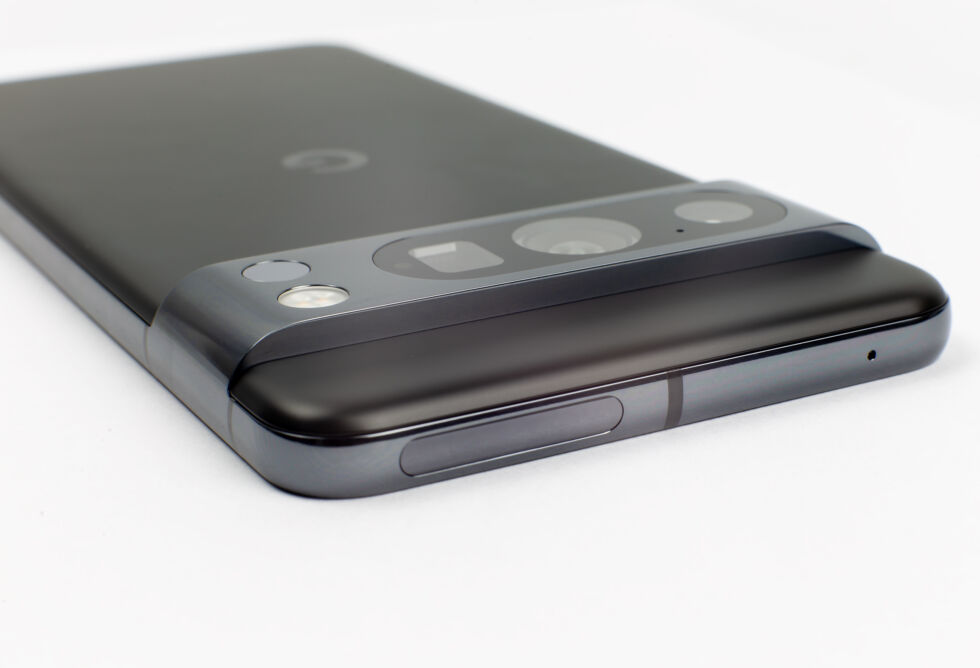

Pixel 8 Pro review—The best Android phone
source link: https://arstechnica.com/google/2023/10/pixel-8-pro-review-the-best-android-phone/
Go to the source link to view the article. You can view the picture content, updated content and better typesetting reading experience. If the link is broken, please click the button below to view the snapshot at that time.

Now just take that $100 off —
Pixel 8 Pro review—The best Android phone
7 years of updates, a flat screen, and better face unlock highlight Google's latest.
Ron Amadeo - 10/11/2023, 5:00 PM

Google is listening. Reviewing phones means that we usually complain—a lot—about phone designs, about things that could be better, and about decisions that don't make a ton of sense. Usually it feels like talking to a wall; manufacturers ignore us and keep doing whatever they want.
The Pixel 8 is different, though. This phone feels like it's taking some of our long-standing pet peeves into account and is finally doing something about them. Tired of pointless curved screens that distort your image? Fixed. Want an update support timeline that finally rivals iOS? Check. Fixing flaws with the previous model, like face unlock? Double check. Compared to where the Pixel line was just a few years ago, Google Hardware is turning in phones that are polished, practiced, and full of great decisions.
The Pixel design just keeps improving
-
The Pixel 8 Pro display looks great.
-
The camera bump still sticks out across the whole back of the phone, which I like.
-
The flat screen means the sides are taller, which makes the phone nicer to hold.
-
The sim slot is still here.
-
Introducing USB-C! No, wait, that's been here for nine years.
| SPECS AT A GLANCE | ||
|---|---|---|
| Pixel 8 | Pixel 8 Pro | |
| SCREEN | 6.2-inch, 120 Hz, 2400×1080 OLED | 6.7-inch, 120 Hz, 2992×1344 OLED |
| OS | Android 14 | |
| CPU | Google Tensor G3
One 3.0 GHz Cortex-X3 core |
|
| GPU | ARM Mali-G715 | |
| RAM | 8GB | 12GB |
| STORAGE | 128GB/256GB UFS 3.1 | 128GB/256GB/512GB/1TB UFS 3.1 |
| BATTERY | 4575 mAh | 5050 mAh |
| NETWORKING | Wi-Fi 7, Bluetooth 5.3, GPS, NFC, 5G mmWave & Sub-6 GHz | Wi-Fi 7, Bluetooth 5.3, GPS, NFC, 5G mmWave & Sub-6 GHz, UWB |
| PORTS | USB Type-C 3.1 Gen 1 with 30 W USB-PD 3.0 charging | |
| REAR CAMERA | 50 MP Main 12 MP Wide Angle |
50 MP Main 48 MP Wide Angle 48 MP 4x Telephoto |
| FRONT CAMERA | 10.8 MP | 10.8 MP |
| SIZE | 150.5 x 70.8 x 8.9 mm | 162.6 x 76.5 x 8.8 mm |
| WEIGHT | 187 g | 213 g |
| STARTING PRICE | $699 | $999 |
| OTHER PERKS | IP68 dust and water resistance, eSIM, wireless charging, in-screen fingerprint reader |
Google is still making steady improvements to the design that started with the Pixel 6, and the Pixel 8 Pro feels like one of the best hardware designs out there. First up, Google is finally dumping the years-long failed experiment of curved displays. Samsung started the curved display trend back in 2014 when it figured out how to bend OLED displays. Thanks to the huge influence of Samsung's display division, from then on most flagship Android phones had the long edges of their displays curve into the bodies.
Samsung's scientists were so preoccupied with whether they could bend a display that they didn't stop to think if they should. There was never a good argument for doing this when all the content in the world—apps, websites, photos, and videos—was meant to be displayed on a flat surface. The only thing the curved display accomplished was making the sides of an Android phone distorted and unusable for content, necessitating bigger margins on the sides of the display. It made the display more likely to capture glare, and it made it easier to accidentally touch the sides of the display while holding it, which can stop touchscreens from responding correctly.
The flat display on the Pixel 8 Pro marks the healing of this self-inflicted wound. The entire surface area of the Pixel 8 Pro display is usable now, so full-screen videos and photos look great. The sides of the phone get to be bigger and flatter in a thinner device, and that greater surface area results in a better grip. It's easier to hold the phone without touching the screen. I hope other manufactures follow suit.
The back panel is a soft-touch glass material that we previously saw on the Pixel Fold. We were big fans of that finish, and it's great on the Pixel 8, too. The soft-touch glass is grippier than a normal glass back and hides fingerprints a bit better, so we're glad to see it return. Instead of the ultra-shiny glass back, this material has a matte or satiny finish, and it looks gorgeous on our black review unit.
I wish I could say that the aluminum sides and camera bar also had a great finish, but the aluminum still has a mirror polish. The mirror polish is extremely prone to scratches just from normal use. I can already see some after a few days, and the Pixel 6 Pro and 7 Pro, with similar finishes, have not aged well. The mirror polish is also slippery and prone to catching fingerprints. It doesn't have to be this way. A better answer exists if you just look at the cheaper Pixel 8, which has a brushed, matte aluminum finish that is grippier, doesn't show fingerprints, and is more durable. Just as with the curved-screen fiasco, Google seems to think that a flagship phone has to look this way and doesn't appear to consider usability concerns.
Speaking of the sides of the phone, one thing you'll notice along the top edge is a big oval cutout for the mmWave antenna. I don't want this component and don't want to pay for it. mmWave antennas add between $50 and $100 to the cost of a phone and aren't particularly useful, as carriers have mostly given up on the technology. The last count I saw had Verizon as the "market leader" with 0.8 percent availability, and current carrier investments are all around C-Band 5G rather than this difficult-to-use spectrum. mmWave is the WiMax of the 2020s: an abandoned, dead-end technology that's going nowhere. Dumping mmWave is a super-easy, no-brainer cut to the bill of materials that most people will never notice. Apple was smart enough to start cutting this back in 2022, and hopefully more companies will follow.
All the other good things about the Pixel line are still here. The camera bar continues to be the best camera bump design on the market. Unlike the smaller camera bumps out there, the bar allows the phone to rest on the table in a stable position, no matter where you tap it. The camera bar's sharp 90 degree bottom gives you something to stick your index finger against when holding the phone, giving it a bit more support. In a world where manufacturers feel the need to cycle through every possible camera bump design, I really just want something that works well and has these bonus functionality bits. Please don't ever change the camera bar, Google.
Advertisement
Face unlock: Now usable
Another big thing we've complained about in the past that has been fixed: face unlock. The iPhone does face unlock with a bevy of purpose-built sensors that can create a 3D map of your face, while the Pixel 7 has a dubiously secure face unlock system that works only via the front selfie cam. We're not the only ones who questioned the security of a camera-only face unlock—Google did, too, and it set up the OS so that a face-unlocking phone would not grant the same amount of access as unlocking with a fingerprint. The result was that doing a face unlock and then opening a secure app like Google Pay would bring up another lock screen because face unlock wasn't good enough.
The real problem is that face unlock overrode the fingerprint reader lock screen, so if the phone recognized your face, it would immediately do a weak-security unlock, disable the fingerprint reader, and then you would need to open a secure app to really unlock the phone. As a heavy user of Google Pay (or whatever it's called this week), that led me to just disable face unlock completely because it would open the phone at checkout but not open Google Pay—and I would fail the payment.
Behind the scenes, Android has multiple security tiers for biometrics, with fingerprint readers hitting the highest Class 3 "biometric strong" security tier, which will unlock the phone and grant access to high-security apps. The face unlock on the Pixel 7 was the Class 1 "convenience" tier, which only unlocks the phone and doesn't grant access to Android's cryptographic keystore, so opening a high-security app would make a second lock screen appear. This year face unlock is a Class 3 biometric, just like the fingerprint reader, so logging in with your face is just as good as your finger.
Assuming that the new face unlock is actually secure, this is a huge improvement! Face unlock and the fingerprint reader can now complement each other. Face unlock is great if your fingerprint read fails due to misplacement or having a wet finger or the million other things that can go wrong. Similarly, there are plenty of times when face unlock doesn't work—when wearing sunglasses, masks, hats, or when you just aren't looking directly at the phone. You unlock your phone many, many times a day, so having multiple, redundant ways to get in on the first try makes sense. I'm often not sure which method works when I try to log in; all I know is that I get in, and it feels fast and convenient.
Recommend
About Joyk
Aggregate valuable and interesting links.
Joyk means Joy of geeK

